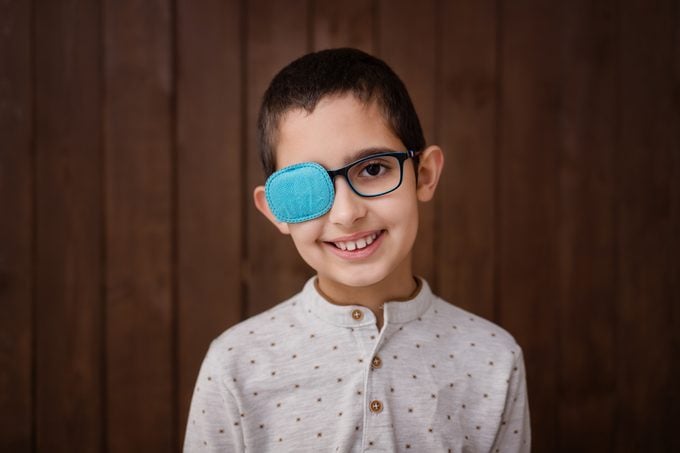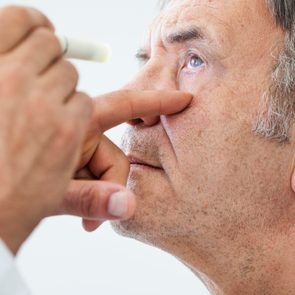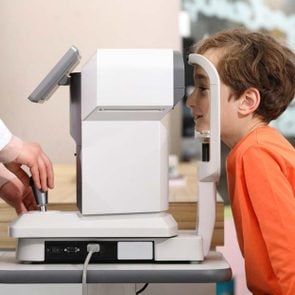What Is Lazy Eye?
Updated: Oct. 27, 2021
Lazy eye or amblyopia occurs when your two eyes aren't in sync, but identifying and treating this condition early can prevent any long-term vision issues.
What is lazy eye?
Amblyopia or lazy eye develops when your brain can’t recognize the sight from one eye. As a result, it relies more and more on the stronger eye, and vision in the affected eye becomes gradually weaker.
(The reason it’s called lazy eye is that one eye is stronger and works better than the other.)
“One eye is not getting a clear image, and the brain says ‘I will pay attention to the eye with the clear image, not the other one,'” explains Kammi Gunton, MD, an ophthalmologist at Wills Eye Hospital in Philadelphia.
Identifying and treating amblyopia early can prevent any long-term vision problems. Here’s everything you need to know.

Lazy eye: understanding your risks
Amblyopia begins in childhood and affects up to three of every 100 children, according to the National Eye Institute.
Risks for developing this condition include:
- being born too early
- being born too small for gestational age
- family history of amblyopia, childhood cataracts, or other eye conditions
- history of developmental disabilities
Strabismus vs. amblyopia
The most common cause of amblyopia is a refractory error such as nearsightedness (trouble seeing far away), farsightedness (trouble seeing things up close), and/or astigmatism (which can cause blurry vision), Dr. Gunton says.
One type of amblyopia, strabismus, is a misalignment of the eyes. Your eyes may not line up, and/or one may drift up, down, or to the side, explains Wadih Zein, MD, staff clinician at the Ophthalmic Clinical Genetics Section of the National Eye Institute in Bethesda, Maryland.
Parents are often able to spot strabismus because they can see that their child’s eye is wandering.
“Strabismus is usually obvious, but sometimes the angle is so small that parents can’t see it,” Dr. Zein says.
It’s not as easy to pick up amblyopia from a refractory error without a vision test. There can be red flags, including squinting, shutting one eye to focus, and/or tilting the head when watching TV.
These are 7 silent signs your child might have a lazy eye.
Diagnosing amblyopia
“Amblyopia needs to be screened for and, if identified, needs to be addressed, and if it is addressed early enough, there’s a good chance that patients will regain optimal vision in the affected eye or eyes,” Dr. Zein says.
Screening for amblyopia is sometimes as simple as your child reading the eye chart during a routine well visit with the pediatrician.
The American Academy of Pediatrics recommends a vision screen by 6 months of age as part of a well visit to check for vision development and alignment of the eyes. Further yearly screening occurs as the child ages and vision continues to develop.
“If a refractory error is picked up during a routine vision screen, your pediatrician will likely refer your child to a pediatric ophthalmologist for further evaluation,” Dr. Zein says.
How to fix lazy eye

If your child has a lazy eye, the key is to intervene when vision is still developing.
“If we can get kids diagnosed before age 3 and start treatment, our success rate is much better,” Dr. Gunton says. “After the age of 12, it’s almost impossible to treat. You don’t have time to waste.”
If the better-seeing eye becomes diseased or injured, the “lazy” one can’t compensate, she notes.
In addition to affecting vision, an untreated lazy eye can affect the quality of life in older kids and adults.
Dr. Zein agrees: “If this window closes, it becomes much more difficult to get treatment, and then the child becomes an adult with a lazy eye.”
Lazy eye treatment options
Treatment depends on the cause of the amblyopia, he says.
With strabismus, your eye doctor will likely suggest patching the good eye so your brain can learn to work with the “lazy” one. Doctors can also use eye drops to relax and dilate the better-seeing eye so vision is blurry and you must rely on the weaker eye, he says.
Sometimes corrective glasses or lenses and/or surgery will also be needed for strabismus. During strabismus or eye muscle surgery, the eye muscles can be tightened or loosened so the eyes are no longer misaligned, according to the American Academy of Ophthalmology.
When amblyopia is from a refractive error, glasses can usually improve vision and make sure both eyes are on the same page.
“If eyeglasses are not enough, patching or penalizing the better-seeing eye can also play a role,” Dr. Zein says. It’s also important to treat any underlying eye disease that may be causing amblyopia, such as cataracts.
The last word
Catching amblyopia early before vision has fully developed is the best way to stave off any lasting consequences. The best way to do this is through vision screening during your child’s annual well visits.




















